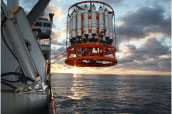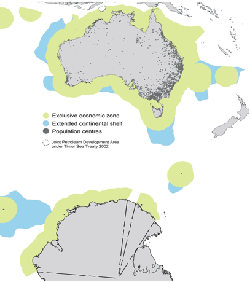P6 Science
 |
 |
Enlarge Image The CTD rosette hanging over a South Pacific sunset during P6. (Mark Rayner CSIRO)
|
 | Introduction
Here we describe the CLIVAR hydrography program and some of science specific to the 2009/2010 P6 line. We begin with an article about the climate in Australia where we began our cruise.
If you look to your left you will see other articles about our work and our science groups.
Climate Change from an Australian perspective
 |
 |
(Mark Rayner CSIRO)
 |
Enlarge Image Australia has one of the world largest coastal and marine areas. In fact the size of Australia marine zone is larger than the continent itself. Australia relies heavily on the coastal and marine environs. Fishing, Aquaculture Tourism, are key industries that climate change represents a threat to the economic and ecological sustainability, as well as the critical ecosystems that underpin the beachside lifestyle enjoyed by millions of Australians.
 |
(Mark Rayner CSIRO)
|
 | Mark Rayner
The Australian continent is the driest, flattest, hottest and most climatically aggressive of all inhabited continents. Climate change is one of the greatest social, economic and environmental challenges of our time. Human activity is causing the climate to change. This, in turn, is having an impact on Australia's rainfall, temperatures, bushfire frequency, health, heritage and biodiversity for current and future generations.
During the past 100 years, global average surface temperature increased by about 0.7°C. Since 1910 the average temperature of Australia has risen by about 1°C. Although these increases sound small, they have a big impact on the world's climate.
How will I be affected?
It is difficult to precisely predict what the impacts of climate change will be, as they vary with each region. Best estimates are that by 2030 Australia will face:
- a further 1ºC of warming in temperatures
- up to 20 per cent more months of drought
- up to 25 per cent increase in days of very high or extreme fire danger
- increases in storm surges and severe weather events.
Australia is very vulnerable to the effects of climate change. We are already the driest inhabited continent on earth, heavily exposed to the dangers of extreme heat and drought. We are home to many globally important and vulnerable ecological systems. Australians are overwhelmingly coastal dwellers. Our industries and urban centres face ongoing water limitations. Our economy, including food production and agriculture, is under threat.
The longer the world waits to act on climate change, the more it will cost and the worse its effects will be.
In 2006-07, the gross value of Australian fisheries and aquaculture production was $2.18 billion, with a total export value of $1.49 billion. Approximately 35 per cent of Australia’s gross value production, or $793 million, was from aquaculture production.
The commercial fishing industry employed approximately 9700 people in 2006, with a further 6200 employed in associated wholesaling and processing industries.
The most valuable species in 2006-07 were rock lobster ($441 million), salmonids ($281 million), prawns ($265 million), abalone ($216 million) and tuna ($161 million).
Climate change impacts
The impacts of climate change on marine ecosystems and fish stocks are expected to be driven by changes in temperature, rainfall, ocean chemistry, ocean currents, nutrients and extreme weather events. These impacts are likely to vary by region. For instance, increases in sea surface temperature are potentially a key impact on south-east fisheries, while northern fisheries are most likely to be affected by changes in rainfall.
Increased water temperatures
It is projected that the greatest increase in sea surface temperature will occur off south-east Australia. Summer sea surface temperature records already indicate an increase of more than 1°C since the 1940s off the east coast of Tasmania.
Increases in sea surface temperature are likely to affect the distribution of many species in the south-east and offshore, with potential flow on effects to the broader marine ecosystem.
The projected increase in sea surface temperature may also have adverse impacts on the production of cool-water farmed aquaculture species, such as the salmon production industry in Tasmania.
Changing rainfall patterns
Coastal aquaculture may be impacted by altered rainfall patterns due to changes in salinity levels, and suspended sediment and nutrient loads.
The projected decline in rainfall may affect freshwater aquaculture industries as a result of reduced water availability.
Changes in rainfall may negatively affect barramundi, prawn and mud crab production in northern fisheries.
Ocean chemistry
Changes in ocean chemistry may affect plankton communities that underpin marine food webs, with possible flow-on effects to other species such as commercial fish. Ocean acidification may also affect the eggs and larvae of commercial species, and affect some aquaculture species, such as mussels and oysters. The vulnerability of coral reefs to changes in ocean chemistry may also have implications for reef-dependent fisheries.
Extreme weather events and rising sea levels
Climate change is expected to result in more intense storms, which may impact offshore and coastal aquaculture stock and infrastructure.
Coastal habitats, which provide important breeding and nursery grounds, may be affected by sea level rise due to climate change. For instance, the extent of mangrove areas, which provide critical habitat for prawns and estuarine fish, may be reduced in the Gulf of Carpentaria as a result of sea level rise.
Australians have a long history of coping with a highly variable climate, and our nation enjoys a high standard of living, so we are well placed to adapt and prepare for some of these impacts for climate change.
Because of the amount of greenhouse gases already in the atmosphere, some ongoing changes in the climate are now inevitable.
Both climate change and climate variability pose serious challenges for our communities, industries and environment. For example:
- Australia is experiencing the worst drought in recorded history, with many cities and regions facing serious water shortages
- average annual rainfall is projected to decrease over southern Australia in the coming decades
- Australian average temperatures are projected to rise by up to two degrees by 2050
- sea level around our coastline could rise by between 18 and 79 cm or more this century.
Originally published: December 28, 2009
Last updated: December 28, 2009 | 



